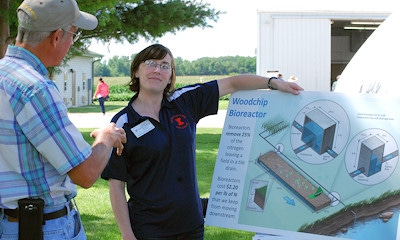
The Illinois Nutrient Loss Reduction Strategy (IL-NLRS) provides farmers a roadmap for reducing nutrient loss on their farms. Laura Christianson, water quality extension specialist with the University of Illinois, says the NLRS doesn’t focus on “pointing fingers”, but “provides options and solutions” for farmers to implement on their farm.
Related article: 5 things you need to know about nutrient loss in Illinois
Christianson notes nutrient loss reduction practices fall into three categories: nitrogen application management, in-field cropping management practices and edge-of-field practices. She says farmers are making great strides with nitrogen management, but it’s not enough.

THE BREAKDOWN ON BIOREATORS: Laura Christianson, water quality extension specialist with the University of Illinois, explains how woodchip bioreactors can make a big impact nutrient loss reduction. “We want a new practice in every field,” says Christianson.
“Improved nitrogen management is something we should all be thinking about anyway,” says Christianson. “Even if everyone does perfect nitrogen management practices, it will not solve our water quality problems. It will only move the needle a little bit.”
Christianson says farmers need to consider in-field practices, such as cover crops, or edge-of-field practices such as woodchip bioreactors and wetlands.
Explaining a woodchip bioreactor
A woodchip bioreactor is a woodchip-filled trench where tile drainage is routed. “Inside the trench, good bacteria naturally come from surrounding soils and live on the woodchips,” says Christianson. “The bacteria convert the nitrates flowing in the water to nitrogen gas, which is a natural part of the nitrogen cycle.”
Christianson explains this “super buffet” of food for the bacteria allows them to convert nitrates to nitrogen very efficiently.
The bioreactor includes inflow control structures to by-pass the woodchip trench and keep drains running during heavy flow times. An outflow control structure gives farmers the ability to regulate how long water is held in the trench; such as less time in the summer during slow drainage and more time in the spring during heavy flow. Christianson says bacteria need more time to do the job effectively during heavy flow periods.
One woodchip bioreactor that handles tile water from 30 to 80 acres costs roughly $10,000.
“It’s a big upfront expense,” Christianson explains. “But the woodchips last up to 10 years.” According to the IL-NLRS, reactors can reduce nitrate loss by 25% when used on 50% of tile-drained land.
For comparison, the IL-NLRS states splitting nitrogen applications 50% in the fall and 50% in the spring will reduce nitrate loss on tile drained soil by 7.5% to 10%.
About the Author(s)
You May Also Like




